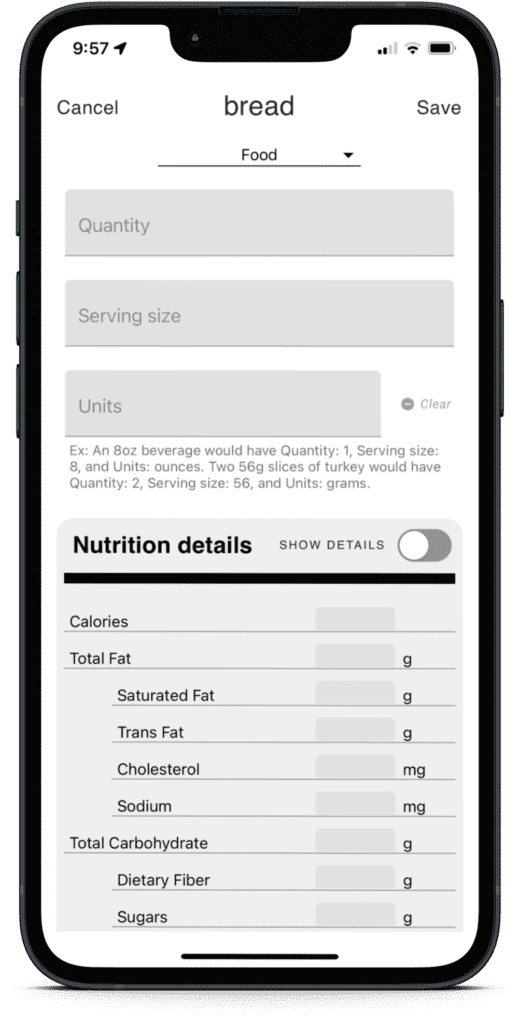Introduction
Does eating a certain food send your stomach into spirals? You’re not alone. Achieve a healthier, happier life by identifying foods that trigger your reactions. Food journaling helps identify if the source of your stomachaches could be a chronic disease.
Chronic diseases are conditions that last one year or longer, require ongoing medical attention, and/or limit activities of daily living. Chronic diseases include diabetes, high blood pressure, and heart disease. Our goal here is to give you an overview of how tracking food can help identify and effectively manage chronic diseases.
The Benefits of Food Journaling
Food journaling is a powerful tool for understanding your body and how it responds to food. It helps identify potential triggers that lead to chronic illness and gives you an idea of which foods best suit your body.
The benefits of food journaling include the following.
Improved nutrition
Keeping track of what you eat encourages you to make healthier choices. This is especially true if you have not been eating enough or poorly. Food journaling also helps prevent overeating by keeping track of portion sizes and calories consumed (or burned).
Understanding food triggers
Avoid eating foods that cause symptoms such as bloating or gas after eating them. If this often happens, those same symptoms may become less severe due to reduced exposure levels from avoiding these problematic foods altogether!
Understanding food triggers is critical, especially for people trying to identify something like Celiac or a food allergy. Ignoring the harmful effects of food on your body can lead to lifelong illness and discomfort.
Food Journaling Techniques

The best way to track food is by recording what you eat, when and how much. This will help you identify patterns in your eating habits contributing to chronic disease. Sometimes a specific environment can lead you to consume food items that don’t agree with your digestive system!
Keep track of where you’re at when you’re eating a meal, too, if you want those extra insights.
Time of day – Record the time of day when you eat each meal or snack.
Quantity – Record the amount of each food item consumed and any condiments used (e.g., butter). Be sure to include beverages like water, coffee, or tea with meals/snacks. Those calories can be calculated into total daily intake along with other foods consumed during the same time.
Type of Food – Record whether it was solid or liquid, e.g., “apple” versus “juice.” Also, note if any additives, such as sweeteners, were added before you ate the food.
Feelings & Emotions – Note how hungry you were at this particular time. Was there anything else going on emotionally at this moment that could have affected appetite? Did anything stressful happen during mealtime that might have influenced your choice(s)?
Nutrition Basics
Macronutrients – These provide calories and energy to your body, such as fat, protein, and carbohydrates.
Micronutrients – These are vitamins and minerals that help your body function properly. Your body needs more than 100 different micronutrients to function correctly; however, you only need a small amount of each of these nutrients every day because they work together in various ways within the body (for example, vitamin D helps calcium absorption).
Water intake – Drinking plenty of water throughout the day is essential. That’s about eight glasses for men and seven for women. How do you know if you’re getting enough? Try tracking how much liquid goes into your system using an app like MyFitnessPal, Fitbit, or logging everything else on paper or digitally through another app.
Identifying Food Triggers
Food triggers are the most common cause of chronic illness. Food triggers occur when you eat food incompatible with your body’s biochemistry. They can manifest as digestive issues such as bloating or constipation (or both), skin problems like eczema or psoriasis, fatigue, and brain fog.
Common trigger foods include:
- Dairy products (milk, cheese)
- Eggs and egg-based dishes (like quiche)
- Wheat products (bread, pasta, bagels)
- Soy and soybean oil (a type of legume)
- Peanuts and peanut oil (a type of legume)
- Tree nuts and their oils
- Sesame
- Fish and shellfish
Using Food Journals to Diagnose Chronic Illness
One of the most effective ways to use food journals is to recognize patterns in your eating habits. For example, if you notice that certain foods worsen or improve your symptoms, this can be helpful information when talking with a doctor.
Food journaling can also help monitor progress when dealing with chronic diseases like Celiac, diabetes, or heart disease.
Try using the Best Life mobile app built by our nonprofit! You can easily add Food Events and log extra nutrition details or keep a daily food note with an easy-to-recognize tag. You can make your food journaling effort as detailed as you want over time.
By using Best Life, you can know your data is protected under our nonprofit’s regulatory model. Learn more about why it matters in our FAQ!

Tips for Successful Food Journaling
Consistency
Consistency is important when food journaling because it helps you form a habit of tracking your meals, making it easier to identify patterns in your eating habits. By keeping track of what you eat daily, you’ll be able to see which foods are contributing to your symptoms or making them worse.
Inconsistencies in your food journal can also lead to tracking inaccuracies, making it difficult to diagnose chronic illness or make informed decisions about your diet. For example, if you forget to record a meal, you may not be able to accurately calculate your daily calorie intake or identify potential trigger foods.
By being consistent with your food journaling, you’ll also have a clear record of your progress over time. This can help track your symptoms and see how changes in your diet or lifestyle affect your overall health.
Being thorough
Being thorough in your notes and tracking is incredibly important. It helps to identify unknown allergies or reactions to help manage a chronic disease or condition. Imagine that you experience a reaction when allergy season kicks up; you may be allergic to ragweed pollen. But did you know if you are allergic to ragweed, you may also develop reactions to bananas or melons?
Honesty
Honesty is also essential when food journaling. Being honest allows you to track what you eat and how much you eat accurately. Being honest about your consumption can help you identify potential trigger foods or habits contributing to your chronic illness.
For example, if you have a food intolerance to dairy but continue to have it regularly, you may not accurately identify it as a trigger food. That is unless you are honest about your consumption in your food journal. Similarly, if you tend to eat larger portions than you realize, being honest about portion sizes can help you better manage your calorie intake and maintain a healthy weight.
Honesty with yourself about your emotions and feelings when eating can also help identify patterns and triggers. If you tend to eat when stressed or anxious, tracking those feelings can help you develop more effective coping mechanisms and strategies for managing those emotions without turning to food.
Taking notes on the go
Taking notes on the go is essential when food journaling because it helps to accurately capture what you eat throughout the day, even when you are away from home or in a rush. According to Kitchen Cabinet Kings, a daily food journal should be accurate and consistent and tell the truth about your eating habits, even if they are ugly.
By taking notes even when you’re out and about, you can ensure you don’t forget any foods you eat and record them accurately. Additionally, taking notes on the go can help you identify patterns in your eating habits and change your diet to improve your health.
Tools for Tracking Food

There are a number of tools for tracking food. These include note-taking apps, calorie counters, and physical journals. The most important thing when first starting with food journaling is to make it an achievable and easy thing to do.
Nothing is more frustrating than having to stop everything about your life to dig through a bag and find a food journal. Instead, consider using helpful mobile apps or similar tools.
Be careful which you choose, though. You don’t want to get stuck using something that traps you with a premium price tag or resells your data for its own gain.
Final Thoughts
In this article, we’ve reviewed the importance of tracking food for chronic illness. We’ve also discussed some of the best food journaling techniques and tips for identifying food triggers and diagnosing your condition.
Start your food journaling efforts and start curbing the effects of chronic disease! You’ve got nothing to lose and everything to gain.
Sources
Definitions and Facts on Celiac Disease
Food Allergies, Causes, Symptoms
Food Allergies and Intolerance, American Academy of Allergy, Asthma & Immunology
Soy Allergy Diet, University of Rochester Medical Center
Who we are
The Live Learn Innovate Foundation is a 501(c)3 nonprofit entity. LLIF empowers software users to regain control of their personally generated health data, gain intuitive insights about their social data, learn the impact of their environment on health, and build a foundation of data analytics. LLIF helps strengthen data research, makes data more accessible to academics, and fosters innovation in economic development.
Use cases for secure, private data aggregation appear everywhere. It expands to family care, community growth, agricultural planning, and many more things still unseen. Help us keep going by getting involved today.
3 Responses